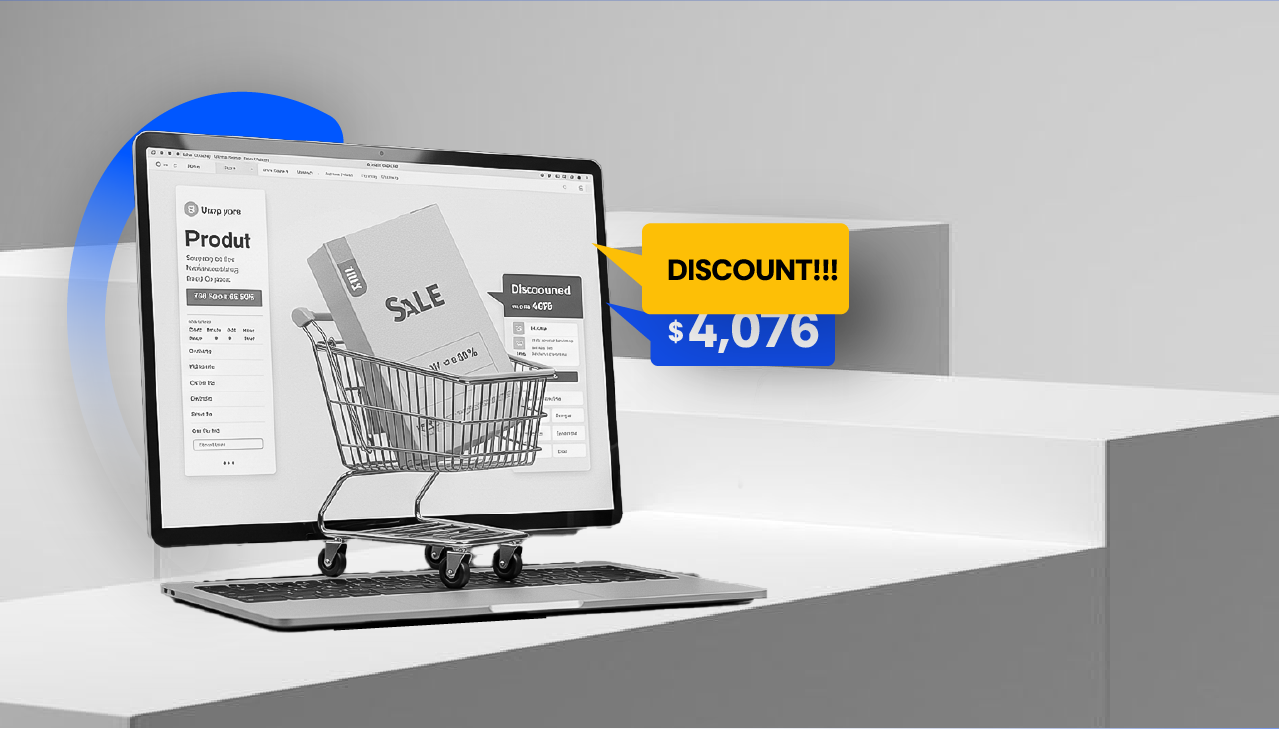The biggest problem in business today isn’t innovation—it’s information. You could have the best website, the finest product, the perfect pricing strategy, and yet still fail to convert visitors into customers.
Why? Because you have no idea what’s actually happening on your site. Now, let’s get one thing straight: website analytics is the fundamental force behind smarter business decisions. You simply cannot improve what you don’t measure.
The beauty of running a business today is that data is abundant, almost obnoxiously so. Every click, every scroll, every drop-off is a story waiting to be understood. Analytics gives you the ability to dig into these interactions, not just to see what people are doing, but to understand why.
Research by McKinsey shows that data-driven organizations are 23x more likely to acquire customers, 6x more likely to retain them, and 19x more likely to be profitable.
So, if you want to thrive in today’s market, understanding your audience through data is non-negotiable.
Now, don’t get it twisted—analytics alone doesn’t move the needle. It’s the actions you take based on those insights that make the difference.
With the right analytics tools, you remove the friction of uncertainty, turning raw data into a clear roadmap for business growth.
In the context of your website, analytics tells you who your visitors are, how they find you, what they do, and most importantly, why they leave. The trick is not to look at analytics as a one-time check-up but as the heartbeat of your business—constantly monitored, measured, and acted upon.
Which brings us to the point of this article: the tools. You want the best insights without breaking the bank, and luckily, there are plenty of free analytics tools out there that help you do just that.
Let’s explore the top 7 options you can start using today to gather real, actionable insights that will push your business forward.
1. Use Google Analytics to understand what’s happening on your website
If you’re serious about understanding your web traffic, you’ve probably already heard of it. But there’s more to Google Analytics than just tracking page views and user sessions. It’s about understanding user behavior in a way that gives you clear, actionable insights.
Let’s break it down for you:
Google Analytics is like a high-powered telescope pointed at your website. It allows you to see who’s visiting, where they’re coming from, and what they’re doing once they get there.
It’s a one-stop-shop for quantitative data—traffic sources, page popularity, session durations, bounce rates—everything you need to know how your audience moves around your site.
What makes Google Analytics particularly powerful is its integration within the Google ecosystem. Imagine combining your Google Ads data with your analytics data; you get a clear path from your ad spend to user actions.
Businesses effectively using Google Analytics see 23% higher profitability compared to their competitors. But, the real value isn’t just in the metrics; it’s in connecting those metrics to every part of your digital ecosystem.
The downside? It’s not for the faint-hearted. Google Analytics comes with a bit of a learning curve, especially since the shift to GA4. But if you’re willing to learn, it’s worth it. And best of all, it’s free—at least for most small to mid-sized businesses.
Which brings us to an important question: what if you need insights that Google Analytics can’t give you? Qualitative data—the why behind the what? Don’t worry, we’ve got other website analytics tools on this list that fill those gaps.
2. Use Hotjar to understand the ‘why’ behind user actions
Where Google Analytics tells you what’s happening on your site, Hotjar tells you why it’s happening.
With features like heatmaps, session recordings, and on-site surveys, Hotjar lets you see exactly how users interact with your content, where they’re getting stuck, and what’s capturing their interest.
You’re able to see a recording of a user’s session on your website—their mouse movements, where they scrolled, and where they clicked. It’s like reading their mind (okay, maybe not exactly, but it’s pretty close).
Heatmaps, for instance, show you visually where users are focusing their attention. Are they clicking on something that isn’t actually clickable? Are they ignoring your call-to-action because it’s not prominent enough? These insights help you make changes that remove friction—those small but significant issues that keep users from converting.
Hotjar is particularly useful for startups and small businesses because it’s intuitive, and its free plan provides substantial insights without costing a dime.
Plus, it’s a perfect complement to Google Analytics; together, they give you both the what and the why—a full view of your audience’s journey.
The best part? You don’t need to be a data scientist to understand Hotjar. It’s user-friendly, and it gives you the kind of insights that make you slap your forehead and go, “Oh, that’s why they’re leaving!” And once you know why users are dropping off, you can take meaningful actions to bring them back.
3. Clicky is an easier option for startups
Clicky is for those who love real-time analytics and want a simple, privacy-friendly way to understand their traffic. Unlike the more complex tools we’ve discussed, Clicky takes a minimalist approach to analytics—it gives you the basics, but it gives them to you fast.
You can watch your traffic live, know exactly how many visitors are on your site, what pages they’re viewing, and even what links they’re clicking at that very moment.
Clicky excels at providing this real-time snapshot, which is crucial when you need to understand how immediate changes on your site impact visitor behavior.
It also prides itself on being privacy-conscious. In a world where data privacy is becoming increasingly important, Clicky is fully GDPR-compliant and respects user privacy while still providing useful insights. This makes it a great option for startups or businesses that need to prioritize data protection.
And don’t be fooled by its simplicity—Clicky still gives you essential features like heatmaps, uptime monitoring, and goal tracking. It’s particularly useful for those who don’t need all the bells and whistles, but instead want something that gives them exactly what they need without overcomplicating things.
Plus, the real kicker is that Clicky has a free version for sites with up to 3,000 daily page views. For small to mid-sized businesses, this is more than enough to get started without worrying about budget constraints.
You get the full package without the steep learning curve.
However, if you’re looking for more advanced insights with full data ownership and the ability to customize your reports, Clicky might fall short. That’s where our next website analytics tool really shines.
4. Use Matomo if you’re very conscious about data privacy
If data privacy is a major concern, then Matomo might be the tool for you. Matomo is the privacy-first alternative to Google Analytics, offering a comprehensive set of features while ensuring that you retain 100% ownership of your data.
In an age where data privacy is a constant concern, Matomo helps you sleep a little easier at night. Matomo provides many of the same insights as Google Analytics—website visitor sessions, events, conversions—but the key difference is that you own the data.
Nothing leaves your server unless you choose for it to, which makes Matomo a strong choice for companies that need to comply with strict data privacy regulations like GDPR.
Matomo can be self-hosted, which means you have full control over the data. Alternatively, it’s also available in a cloud-hosted version if you prefer not to deal with the technical side of hosting. With features like heatmaps, session recordings, and customizable reports, Matomo is a well-rounded tool that doesn’t compromise on capabilities.
According to a recent survey conducted by UpCity, approximately 87% of businesses that collect third-party data express concern about losing access to this data due to changing regulations and the phasing out of third-party cookies. Matomo tackles this issue head-on, giving you full transparency and control. The result? You get to understand your audience while keeping their data secure.
The best part is that Matomo offers a free version for small websites, making it accessible to startups and small businesses that don’t want to break the bank for analytics. If you’re in the market for an all-in-one analytics platform that puts privacy first, Matomo is definitely worth a closer look.
That said, while Matomo excels in privacy and ownership, it might lack the kind of intuitive event tracking that makes understanding user interactions effortless. This is where our next website analytics tool really stands out.
5. Use SmartLook if you know a thing or two about event tracking
If you’re tired of manually setting up event tracking and need something more intuitive, Smartlook could be the answer.
Smartlook offers tagless event tracking, meaning it automatically captures every click, pageview, and interaction on your website—no manual tagging required. This feature makes it incredibly easy for you to start gathering insights without the technical complexity.
Smartlook also excels at combining quantitative and qualitative data, providing you with session replays that let you see exactly how users interact with your site.
You’re able to replay every single user session, watching how they navigate through your content and where they struggle. This kind of qualitative insight is invaluable, particularly when paired with Smartlook’s event tracking, which highlights key moments during those sessions.
Let’s say you notice a high drop-off rate on a specific page. With Smartlook, you don’t just get the numbers—you get to see what happened. You can watch the session replays, identify points of friction, and make the necessary changes.
It’s this powerful combination of data that helps you move beyond just knowing that something is wrong to understanding why it’s wrong.
Smartlook is also great for teams because of its collaboration features. You can share sessions, create notes, and work together to improve your website experience. For startups and small businesses that want an all-in-one solution without the setup hassle, Smartlook is an excellent choice. And, yes, it offers a free plan for those just getting started.
However, while Smartlook does a great job with session replays and event tracking, it doesn’t provide the in-depth segmentation and personalization features that more advanced marketers might need. This is where our next website analytics tool takes things up a notch.
6. Use Woopra if you want to go beyond website analytics
Woopra is designed for those who want to go beyond basic website analytics and truly understand the entire customer journey.
It’s an analytics platform that combines user data across different touchpoints—your website, mobile app, email campaigns, and more—to give you a unified view of each customer’s lifecycle.
This is particularly useful if you want to track how individual users move through your entire sales funnel.
Woopra offers powerful segmentation and personalization features. You can create custom user segments based on behavior, demographics, or even real-time activity.
This allows you to dig deep into how different groups of users interact with your site, and tailor your marketing efforts accordingly.
For example, you can create campaigns targeted specifically at users who visited a particular product page but didn’t make a purchase, increasing your chances of converting those prospects.
One standout feature of Woopra is its real-time analytics and journey reporting. You’re able to see, in real time, how your customers interact with your brand across multiple channels.
You can even trigger automated workflows based on user actions, such as sending a follow-up email when a user completes a specific action.
According to McKinsey, personalized customer experiences drive 10-15% higher revenue growth, and Woopra gives you the tools to deliver those personalized experiences seamlessly.
This website analytics tool also integrates with a wide range of tools—CRMs, email marketing platforms, customer support tools—so you can bring all your data into one place and get a full picture of the customer journey.
This integration capability makes it an invaluable tool for companies looking to create data-driven strategies that span multiple channels.
But, Woopra’s advanced features and capabilities might be overkill if you’re looking for a simple, no-frills solution for basic analytics. It’s more suited for businesses that want to go deep into customer journey analytics and leverage data for personalized marketing.
If you’re looking for a done—for—you solution that not only integrates with your website analytics tool and automatically provides a full view of all your data, but also provides what it means for your business and the exact next steps to optimize conversions, the next tool will blow your mind.
7. Here’s a tool that doesn’t just tell you what’s wrong, but also how to fix it
Call us biased but we’ll only tell the truth, promise.
All the tools we’ve listed so far simply tell you what is going well and what isn’t. But, as we established in our intro, analytics alone does not move the needle. It’s the actions you take based on those insights that make all the difference.
And let’s be honest, you’ve sat in front of your laptop, dizzy from all the raw numbers and charts wondering where to even start from, at least once.
GrowthApp isn’t just another analytics tool; it’s an AI-powered conversion optimization solution that integrates seamlessly with website analytics tools like Google Analytics, Clarity, and more.
It provides a full view of your data while going a step further to explain what that data means and how you can use it to your advantage.
For startup founders juggling multiple departments, growth marketers overwhelmed with endless streams of data, and product managers seeking ways to optimize their website, GrowthApp is your answer.
GrowthApp understands that boosting conversions goes beyond traditional website analytics. It starts with analyzing your business’s ideal customer profile (ICP), ensuring that you’re targeting the right audience. From there, it dives deep into the nitty-gritty of your website—analyzing copy, evaluating UI/UX design, and even providing Lighthouse performance analytics to identify areas where speed and accessibility can be improved.
These are features that none of the other tools on this list provide comprehensively.
The beauty of GrowthApp lies in its AI-powered strategies. It doesn’t just stop at showing you the data—it breaks down what it means and gives you actionable next steps.
You’ll have a virtual conversion assistant that not only tells you that visitors are dropping off during checkout, but also suggests optimizing the checkout form or providing a specific incentive to re-engage those users.
GrowthApp effectively acts like a digital marketing and conversion optimization expert in your pocket, helping you turn insights into strategies that boost conversions without extensive marketing experience.
There is no one answer, only the right choice
Your needs are unique, and the right tool for you depends on where you are in your journey, what you’re trying to achieve, and how deep you’re willing to go into the data.
But think about it this way, would you rather use a website analytics tool that will only barrage you with all the things you’re doing wrong?
Or a tool that breaks down percentages and charts to easily understandable words and provides exact next steps to fix the issues and bring your business several steps closer to what you define as success?
Your choice.


